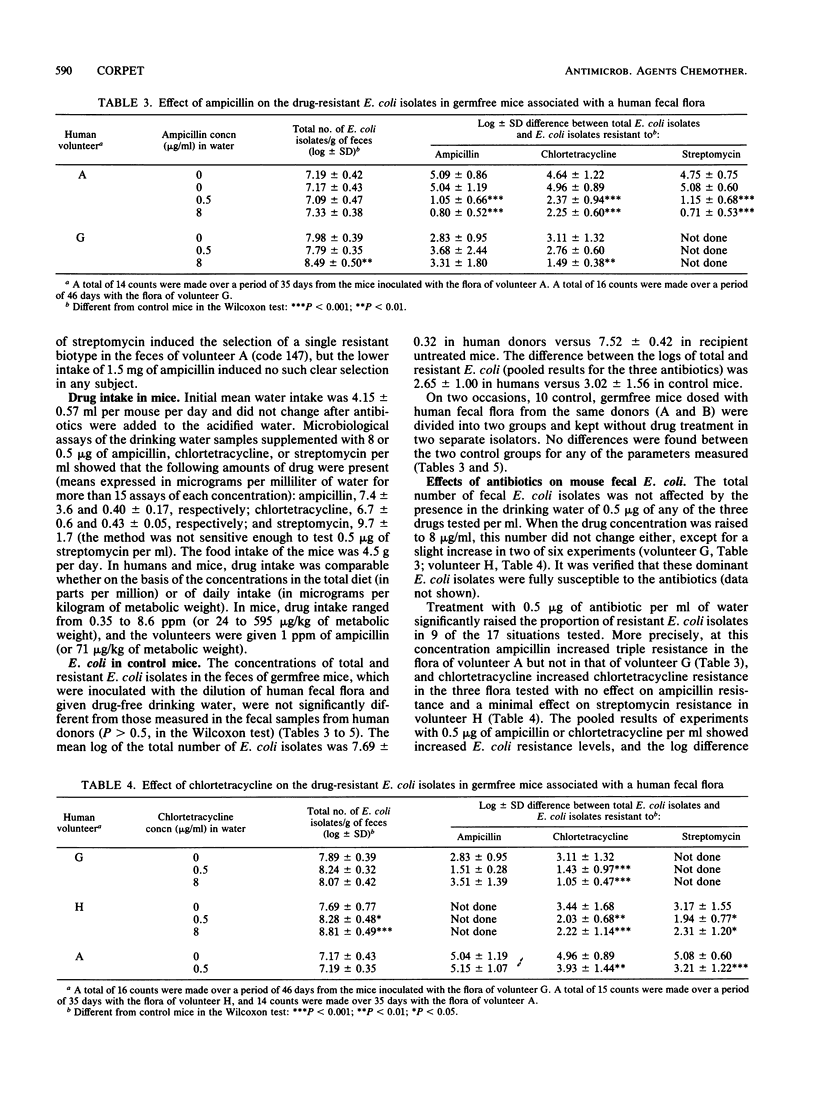Abstract
The effect of residual levels of ampicillin on the drug resistance of fecal flora was studied in human volunteers given 1.5 mg of ampicillin orally per day for 21 days. This treatment failed to have any significant reproducible effect on the number of resistant Escherichia coli in their feces. The effect of continuous administration of small doses of ampicillin, chlortetracycline, or streptomycin in the drinking water was studied in gnotobiotic mice inoculated with a human fecal flora. In this animal model, which is free of many interfering factors, an increase in the fecal concentration of resistant E. coli was observed when the mice were given 0.5 microgram of ampicillin or chlortetracycline per ml of water. This model is therefore a sensitive system for testing the effect of antimicrobial drugs on the resistance characteristics of the intestinal flora.
Full text
PDF






Selected References
These references are in PubMed. This may not be the complete list of references from this article.
- Andremont A., Raibaud P., Tancrède C. Effect of erythromycin on microbial antagonisms: a study in gnotobiotic mice associated with a human fecal flora. J Infect Dis. 1983 Sep;148(3):579–587. doi: 10.1093/infdis/148.3.579. [DOI] [PubMed] [Google Scholar]
- Corpet D. E. The effect of bambermycin, carbadox, chlortetracycline and olaquindox on antibiotic resistance in intestinal coliforms: a new animal model. Ann Microbiol (Paris) 1984 Mar-Apr;135A(2):329–339. doi: 10.1016/s0769-2609(84)80015-0. [DOI] [PubMed] [Google Scholar]
- Corpet D. Influence de faibles doses de chlortétracycline sur la résistance à la chlortétracycline de Escherichia coli, dans le tube digestif de souris axéniques hébergeant des flores complexes d'enfant, de vaue ou de porcelet. Ann Microbiol (Paris) 1980 Nov-Dec;131B(3):309–318. [PubMed] [Google Scholar]
- Crichton P. B., Old D. C. Biotyping of Escherichia coli. J Med Microbiol. 1979 Nov;12(4):473–486. doi: 10.1099/00222615-12-4-473. [DOI] [PubMed] [Google Scholar]
- Datta N., Faiers M. C., Reeves D. S., Brumfitt W., Orskov F., Orskov I. R Factors in Escherichia coli in faeces after oral chemotherapy in general practice. Lancet. 1971 Feb 13;1(7694):312–315. doi: 10.1016/s0140-6736(71)91042-7. [DOI] [PubMed] [Google Scholar]
- Ducluzeau R., Ladiré M., Raibaud P. Effet de l'ingestion de son de blé sur la flore microbienne fécale de donneurs humains et de souris gnotoxéniques receveuses, et sur les effets de barrière exercés par ces flores à l'égard de divers microorganismes potentiellement pathogènes. Ann Microbiol (Paris) 1984 Mar-Apr;135A(2):303–318. [PubMed] [Google Scholar]
- Egger R., Lebek G. Selektion R-Plasmid-tragender E. coli-Keime in einer Mischpopulation durch subinhibitorische Antibiotika-Konzentrationen. Zentralbl Bakteriol Mikrobiol Hyg A. 1985 Nov;260(3):361–368. [PubMed] [Google Scholar]
- Freter R., Brickner H., Fekete J., Vickerman M. M., Carey K. E. Survival and implantation of Escherichia coli in the intestinal tract. Infect Immun. 1983 Feb;39(2):686–703. doi: 10.1128/iai.39.2.686-703.1983. [DOI] [PMC free article] [PubMed] [Google Scholar]
- Freter R., Stauffer E., Cleven D., Holdeman L. V., Moore W. E. Continuous-flow cultures as in vitro models of the ecology of large intestinal flora. Infect Immun. 1983 Feb;39(2):666–675. doi: 10.1128/iai.39.2.666-675.1983. [DOI] [PMC free article] [PubMed] [Google Scholar]
- Hartley C. L., Richmond M. H. Antibiotic resistance and survival of E coli in the alimentary tract. Br Med J. 1975 Oct 11;4(5988):71–74. doi: 10.1136/bmj.4.5988.71. [DOI] [PMC free article] [PubMed] [Google Scholar]
- Hazenberg M. P., Bakker M., Both-Patoir H. C., Ruseler-van Embden J. G., Schröder A. M. Effect of sulphasalazine on the human intestinal flora. J Appl Bacteriol. 1982 Feb;52(1):103–107. doi: 10.1111/j.1365-2672.1982.tb04379.x. [DOI] [PubMed] [Google Scholar]
- Hazenberg M. P., Bakker M., Verschoor-Burggraaf A. Effects of the human intestinal flora on germ-free mice. J Appl Bacteriol. 1981 Feb;50(1):95–106. doi: 10.1111/j.1365-2672.1981.tb00874.x. [DOI] [PubMed] [Google Scholar]
- Hinton M., Allen V., Linton A. H. The biotyping of Escherichia coli isolated from healthy farm animals. J Hyg (Lond) 1982 Jun;88(3):543–555. doi: 10.1017/s0022172400070406. [DOI] [PMC free article] [PubMed] [Google Scholar]
- Hirsh D. C., Burton G. C., Blenden D. C. Effect of oral tetracycline on the occurrence of tetracycline-resistant strains of Escherichia coli in the intestinal tract of humans. Antimicrob Agents Chemother. 1973 Jul;4(1):69–71. doi: 10.1128/aac.4.1.69. [DOI] [PMC free article] [PubMed] [Google Scholar]
- KNOTHE H. [Intestinal flora and antibiotics with special reference to tetracycline]. Dtsch Med Wochenschr. 1963 Jul 26;88:1469–1477. doi: 10.1055/s-0028-1112252. [DOI] [PubMed] [Google Scholar]
- Lebek G., Egger R. R-selection of subbacteriostatic tetracyclin-concentrations. Zentralbl Bakteriol Mikrobiol Hyg A. 1983 Sep;255(2-3):340–345. [PubMed] [Google Scholar]
- Linton A. H., Howe K., Bennett P. M., Richmond M. H., Whiteside E. J. The colonization of the human gut by antibiotic resistant Escherichia coli from chickens. J Appl Bacteriol. 1977 Dec;43(3):465–469. doi: 10.1111/j.1365-2672.1977.tb00773.x. [DOI] [PubMed] [Google Scholar]
- Mamber S. W., Katz S. E. Effects of antimicrobial agents fed to chickens on some gram-negative enteric bacilli. Appl Environ Microbiol. 1985 Sep;50(3):638–648. doi: 10.1128/aem.50.3.638-648.1985. [DOI] [PMC free article] [PubMed] [Google Scholar]
- McCracken A., O'Brien J. J., Campbell N. Antibiotic residues and their recovery from animal tissues. J Appl Bacteriol. 1976 Aug;41(1):129–135. doi: 10.1111/j.1365-2672.1976.tb00612.x. [DOI] [PubMed] [Google Scholar]
- Miller T. L., Wolin M. J. Fermentation by the human large intestine microbial community in an in vitro semicontinuous culture system. Appl Environ Microbiol. 1981 Sep;42(3):400–407. doi: 10.1128/aem.42.3.400-407.1981. [DOI] [PMC free article] [PubMed] [Google Scholar]
- Moore W. E., Cato E. P., Holdeman L. V. Some current concepts in intestinal bacteriology. Am J Clin Nutr. 1978 Oct;31(10 Suppl):S33–S42. doi: 10.1093/ajcn/31.10.S33. [DOI] [PubMed] [Google Scholar]
- Pecquet S., Andremont A., Tancrède C. Selective antimicrobial modulation of the intestinal tract by norfloxacin in human volunteers and in gnotobiotic mice associated with a human fecal flora. Antimicrob Agents Chemother. 1986 Jun;29(6):1047–1052. doi: 10.1128/aac.29.6.1047. [DOI] [PMC free article] [PubMed] [Google Scholar]
- Raibaud P., Ducluzeau R., Dubos F., Hudault S., Bewa H., Muller M. C. Implantation of bacteria from the digestive tract of man and various animals into gnotobiotic mice. Am J Clin Nutr. 1980 Nov;33(11 Suppl):2440–2447. doi: 10.1093/ajcn/33.11.2440. [DOI] [PubMed] [Google Scholar]
- Rollins L. D., Gaines S. A., Pocurull D. W., Mercer H. D. Animal model for determining the no-effect level of an antimicrobial drug on drug resistance in the lactose-fermenting enteric flora. Antimicrob Agents Chemother. 1975 May;7(5):661–665. doi: 10.1128/aac.7.5.661. [DOI] [PMC free article] [PubMed] [Google Scholar]


